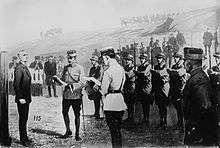Albert Leo Schlageter
| Albert Leo Schlageter | |
|---|---|
 Albert Leo Schlageter, 1918 | |
| Born |
August 12, 1894 Schönau im Schwarzwald, South Baden, German Empire |
| Died |
May 26, 1923 (aged 28) Golzheim, Occupation of the Ruhr, Rhine Province, Weimar Republic |
| Allegiance |
|
| Service/branch |
|
| Rank | Second lieutenant |
| Battles/wars | |
Albert Leo Schlageter ([ˈalbɛʁt ˈleːo ˈʃlaːɡɛtɐ]; 12 August 1894 – 26 May 1923) was a member of the German Freikorps. His activities sabotaging French occupying troops after World War I led to his arrest and eventual execution by French forces. His way of death fostered an aura of martyrdom around him, which was cultivated by German nationalist groups, in particular the Nazi Party. During the Third Reich, he was widely commemorated as a national hero.
Life
Schlageter was born in Schönau im Schwarzwald to Catholic parents.
After the outbreak of the First World War, he became a voluntary emergency worker for the military. During the war, he participated in several battles, notably Ypres (1915), the Somme (1916) and Verdun, earning the Iron Cross both first and second class. Following his promotion to second lieutenant, he took part in the Third Battle of Ypres (1917). After the war and his dismissal from the greatly reduced army, Schlageter described himself as a student of political sciences, but he studied the subject at the most for one year.
About this time, he became a member of a right-wing Catholic student group. Soon he also joined the Freikorps and took part in the Kapp Putsch and other battles between military and communist factions that were convulsing Germany. His unit also took part in the Silesian Uprisings fighting on the German side.
Already close to Nazis, around the time of the Battle of Annaberg of 1921 Schlageter's unit merged with the emerging Nazi Party.[1] During the Third Silesian Uprising of 1921 Schlageter became infamous for persecuting local people and for terrorist actions against both Poles and Germans whom he and his group perceived as opposing his cause.[2]
Following the French occupation of the Ruhr in 1923 he led a group of nationalists in sabotage operations against the occupying force. The group managed to derail a number of trains. On 7 April 1923 information on Schlageter and his activities was obtained by the French, and he was arrested the following day. Tried by court-martial on 7 May 1923, he was condemned to death. On the morning of 26 May he was executed on the Golzheimer heath near Düsseldorf.

On 8 May Schlageter had written to his parents: "from 1914 until today I have sacrificed my whole strength to work for my German homeland, from love and pure loyalty. Where it was suffering, it drew me, in order to help… I was no gang leader, but in quiet labour I sought to help my fatherland. I did not commit any common crime or murder."[3]
Almost immediately after Schlageter's death, Rudolf Höss assassinated his alleged betrayer, Walther Kadow. He was assisted by Martin Bormann. Höss was sentenced to ten years but only served four; Bormann received a one-year sentence.[4]
Heroic symbol to Nazism

After his execution he became a hero to some sections of the German population. Immediately after his death a Schlageter Memorial Society was formed, which agitated for the creation of a monument to honour him. The German Communist Party sought to debunk the emerging mythology of Schlageter by circulating a speech by Karl Radek portraying him as an honourable but misguided figure.[5] It was the Nazi party who most fully exploited the Schlageter story. Hitler refers to him in Mein Kampf.[6] Rituals were constructed to commemorate his death, and in 1931 the Memorial Society succeeded in getting a monument erected near the site of his execution. This was a giant cross placed amid sunken stone rings.[7] Other smaller memorials were also created.
After 1933 Schlageter became one of the principal heroes of the Nazi regime.[8]
In June 1933, National Socialists from the Passau region gathered at the Dreisessel Mountain in the Bavaria Forest to dedicate a Schlageter Memorial.[9] In September 1933, the city of Passau dedicated its own memorial on Hammerberg, overlooking the Inn River.[10] In the spring of 1938, Passau added a Schlageter street and a Schlageter Plaza.[11]
The Nazis renamed the Haus der Technik in Königsberg the Schlageterhaus. Hanns Johst, the Nazi playwright, wrote Schlageter (1933), a biographical drama.[12] It was dedicated to Hitler, and was performed on his first birthday in power as a theatrical manifesto of Nazism. The line "when I hear the word culture, I reach for my gun", often misattributed to Nazi leaders, derives from this play. The original line is slightly different: "Wenn ich Kultur höre ... entsichere ich meinen Browning," "Whenever I hear of culture... I release the safety-catch of my Browning!" (Act 1, Scene 1). It is spoken by another character in conversation with the young Schlageter.[13]
Several important military ventures were also named for him, including the Jagdgeschwader 26 Schlageter fighter-wing of the Luftwaffe, and the naval vessel Albert Leo Schlageter. His name was also given as a title to two SA groups, the SA-Standarte 39 Schlageter at Düsseldorf and SA-Standarte 142 Albert Leo Schlageter at Lörrach. An army barracks on the south side of Freiburg was also named after him; after World War II, the site of this barracks was occupied by the French army and renamed Quartier Vauban after the French military architect. (When the French left in the 1990s, the area became the site of the eco-friendly suburb of Vauban.[14]
Schlageter also featured as a prominent character in British author Geoffrey Moss's 1933 novel I Face the Stars, about the rise of Nazism.
After the war, the main Schlageter memorial was destroyed by occupying Allied forces as part of the denazification process. The Schlageter memorial in Ringelai near Freyung, however, existed until 1977.[15]
The Schlageterinsel or "Schlageter Island" near Soltau continues to bear the name.
References
- ↑ Czapliński (1973). "Związek Wzajemnej Pomocy Robotników Górnośląskich w Bytomiu". Acta Universitatis Wratislaviensis: Historia (in Polish). Uniwersytet Wrocławski. 201: 53–55, 80.
- ↑ various authors (1982). "Schlageter, Albert Leo". In Franciszek Hawranek, Aleksander Kwiatek; et al. Encyklopedia Powstań Śląskich (in Polish). Opole: Instytut Śląski w Opolu. pp. 170, 498. ISBN 978-83-89802-73-6.
- ↑ "Nazi Last Words". calvin.edu. Retrieved 7 October 2015.
- ↑ Biography of Bormann; Biography of Höss
- ↑ Karl Radek. "Karl Radek: "Schlageter Speech" (June 1923)". marxists.org. Retrieved 7 October 2015.
- ↑ Mein Kampf, Chp I
- ↑ Christian Fuhrmeister: Ein Märtyrer auf der Zugspitze? Glühbirnenkreuze, Bildpropaganda und andere Medialisierungen des Totenkults um Albert Leo Schlageter in der Weimarer Republik und im Nationalsozialismus, Zeitenblicke, 3 (2004), N. 1.
- ↑ George Lachmann Mosse, Nazi culture: intellectual, cultural and social life in the Third Reich p 95 ISBN 978-0-299-19304-1
- ↑ Anna Rosmus: Hitlers Nibelungen, Samples Grafenau 2015, pp. 80f
- ↑ Anna Rosmus: Hitlers Nibelungen, Samples Grafenau 2015, p. 81
- ↑ Anna Rosmus Hitlers Nibelungen, Samples Grafenau 2015, p. 150
- ↑ George Lachmann Mosse, Nazi culture: intellectual, cultural and social life in the Third Reich p 96 ISBN 978-0-299-19304-1
- ↑ "Reaching for the Gun by Susan Sontag". nybooks.com. Retrieved 7 October 2015.
- ↑ Tony Paterson, Auto-ban: German town goes car-free, The Independent, 26 June 2009
- ↑ Anna Rosmus: Hitlers Nibelungen, Samples Grafenau 2015, p. 81
External links
| Wikimedia Commons has media related to Albert Leo Schlageter. |